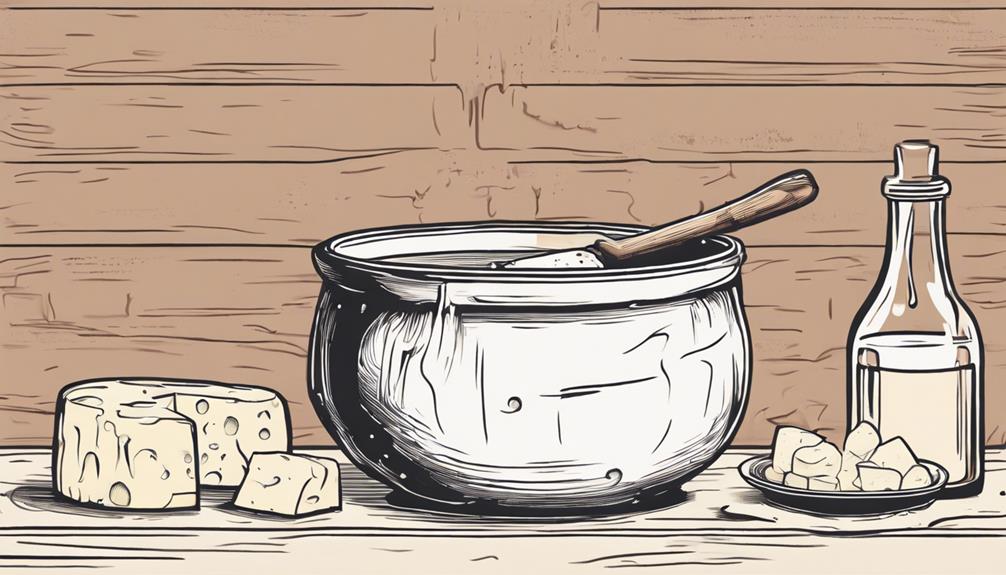How To Become More Self-Sufficient Without Starting a Full-Blown Farm…
Want to start preserving your harvest, making your own soap, or building a backyard root cellar — but not sure where to begin? “Homesteading Advice” gives you instant lifetime access to 35+ practical homesteading books on food preservation, veggie gardening, DIY natural cleaning products (save over $250 per year with this skill alone), brewing, off-grid energy, and a whole lot more…
Click Here To Check It Out Now!
“I recently started making cheese at home and I am thrilled with the process. However, sometimes I encounter uneven curd formation, and I’m not sure why this happens. Could you help me understand what causes uneven curds and how to achieve a more consistent result? Thanks, Kyle, Austin, USA.”
What Causes Uneven Curd Formation?
Hey Kyle! It’s fantastic that you’re getting into cheese making. Uneven curd formation can be frustrating, but understanding the factors that influence it can help you achieve that perfect curd consistency every time. Let’s break down the common reasons for uneven curds and how you can fix them.
Temperature Control
The temperature at which milk is heated plays a pivotal role in curd formation. Here’s what you need to know:
- If the milk is too hot or too cold, it can cause irregular curd formation. Always ensure that your milk is at the appropriate temperature, usually around 86-90°F (30-32°C), unless specified otherwise by the recipe.
- Temperature fluctuations during the process can cause the curds to form unevenly. It’s essential to maintain a stable temperature throughout.
Milk Quality
The type and quality of milk you use significantly influence curd formation. Here’s more on this:
- Freshness: Fresher milk tends to produce better curds. Try to use milk that hasn’t been heat-treated, as pasteurized and homogenized milk can sometimes result in weaker curds.
- Fat Content: Whole milk often provides better results than skim or low-fat milk, producing firmer and more consistent curds.
Rennet Handling
Rennet is another critical factor in curd formation. Let’s look at how to manage it properly:
- Quantity: Using too much or too little rennet can cause problems. Always measure your rennet accurately based on the type (liquid, tablet, or powder) and the recipe requirements.
- Mixing: Ensure that the rennet is evenly mixed with the milk. Inadequate mixing can lead to clumps and uneven curds.
Stirring Techniques
The way you handle the milk and curds also plays a significant role. Here’s what Kyle should be careful about:
- Stirring: Stirring too vigorously can break the curds into uneven pieces. Gentle, consistent stirring helps maintain uniform curd size.
- Cutting Curd: When it’s time to cut the curd, make sure your cuts are as even as possible. Uneven cuts can result in varied curd sizes.
pH Levels
pH is often overlooked but is vital for consistent curd formation:
- Monitoring: Keep a close eye on the pH levels during the cheese-making process. The target is typically around 6.4 to 6.6 before adding rennet.
- Adjustment: If pH levels aren’t right, it can affect curd formation. You might need to adjust your recipe or the amount of starter culture used.
Coagulation Time
Giving the milk enough time to coagulate is crucial:
- Patience: Be patient and allow adequate time for the rennet to do its job. Rushing this step can lead to underdeveloped curds.
- Testing: Check for a clean break before proceeding to cut the curd. Use a sterilized knife to make a small cut in the curd; if the cut holds its shape and releases yellow whey, it’s ready to be cut.
Equipment
Believe it or not, the tools you use can also affect curd consistency:
- Cleanliness: Ensure that all equipment is thoroughly cleaned and sanitized. Contaminants can interfere with curd formation.
- Utensils: Use non-reactive utensils (e.g., stainless steel or food-grade plastic). Reactive materials like aluminum can alter the milk’s chemistry.
Type of Cheese
The type of cheese you’re making can influence the factors mentioned above. Consider the specific requirements for different cheeses:
- Soft Cheese: Generally requires less rennet and a gentler coagulation process, leading to more delicate curds.
- Hard Cheese: Needs firmer curds, thus more rennet and precise temperature control.
Seasonal Variations
Sometimes, external conditions like seasonal variations can impact milk composition and thus curd formation. Take note of these factors:
- Seasonality: Milk composition can vary with the seasons. Winter milk tends to be richer in fat, while summer milk might be more balanced.
- Animal Diet: What the dairy animals eat can affect milk quality. Be aware of changes in feed and how they might impact your cheese-making process.
Environmental Factors
Environmental conditions like humidity and ambient temperature can also play a role:
- Ambient Temperature: High or low ambient temperatures can affect the milk’s temperature and consistency, requiring adjustments to your process.
- Humidity: While primarily a concern during aging, humidity can also affect initial curd formation, especially in artisanal setups.
Final Thoughts…
Kyle, cheese making is both an art and a science, and it looks like you’re well on your way to mastering it. Uneven curd formation can be influenced by various factors, from temperature control and milk quality to rennet handling and stirring techniques. Paying close attention to these details will help you achieve more consistent results.
Don’t get discouraged if things don’t go perfectly every time. With experience and attention to the details we’ve discussed, you’ll be turning out perfect curds in no time. Thanks for your question, it was a pleasure to explain this to you!

